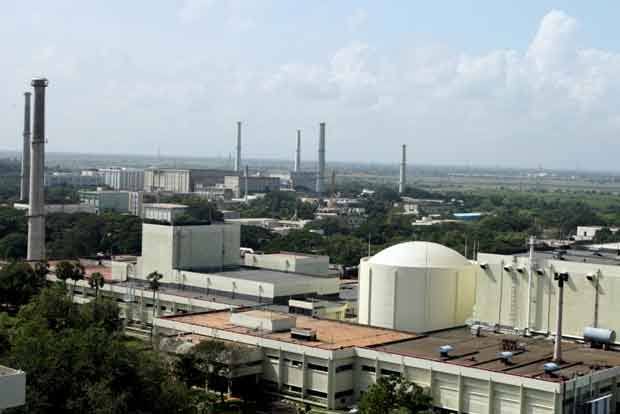First indigenous fast breeder reactor set to achieve criticality

Fuel for the first indigenous 500 MW Prototype Fast Breeder Reactor or PFBR was fabricated under the supervision of the Nuclear Recycle Board at the Fast Reactor Fuel Reprocessing Plant, a INR 400 Crore facility at IGCAR in Kalpakkam. The facility is the only of its kind in the world and is capable of reprocessing both carbide and oxide fuels discharged from the fast reactors.
Last year, the PFBR completed major safety checks, including integrated leak rate testing of the reactor containment and independent verification and validations of systems that require sodium filling in the main vessel. These aspects being critical for safe operation, given that leaks in sodium systems can be exceptionally hazardous. The PFBR comprises a primary sodium circuit, secondary sodium circuits, safety-grade heat removal circuits, and a steam-water circuit. All sodium pipelines inside the reactor containment building (RCB) are double-walled and provided with a hot guard pipe, BHAVINI has noted.
Now India’s first PFBR is set to achieve criticality soon, according to the Atomic Energy Commission (AEC) chief. The reactor, which has been under construction since 2004, is currently undergoing core loading.
The PFBR is designed to produce more fissile material (plutonium) than it consumes, making it a “breeder” reactor. The PFBR is based on closed-fuel cycle, which is the cornerstone of India’s nuclear program. The reactor is expected to go into operation in December.
Referring to capacity addition, Nuclear Power Corporation of India Limited (NPCIL) has begun commercial operation of two units of the indigenous 700MW pressurized heavy water reactors (PHWRs) at Kakrapar Atomic Power Station in Gujarat in the last one year.
Initial fuel loading is complete in another unit of 700MW PHWR at Rajasthan Atomic Power Station. And towards strengthening the fuel supply chain, a green field nuclear fuel complex at Kota in Rajasthan has now entered an advanced commissioning stage, which will mainly cater to the requirement of the forthcoming fleet of indigenously built PHWRs.
The govt recently said it will partner with the private sector in developing and setting up compact nuclear reactors — Bharat Small Reactors — which will generate electricity on a smaller scale and have the advantage of being set up faster and be cost-effective, too.
In addition, Heavy Water Board (HWB) is exporting heavy water to several countries for non-power applications, including medical applications and healthcare.
It will initially use uranium-plutonium mixed oxide (MOX) fuel, with a uranium-238 blanket that will undergo nuclear transmutation to produce more plutonium fuel.
The reactor also has the capability to use thorium-232 as a blanket material, which will transmute into fissile uranium-233 for use in the third stage of India’s three-stage nuclear program. The PFBR incorporates advanced third-generation safety features with inherent passive safety mechanisms to ensure a safe shutdown in case of an emergency.
Once operational, India will become only the second country after Russia to have a commercial fast breeder reactor.
At the dawn of the new era of nuclear renaissance, India stands ready to partner with the agency (IAEA) and other like-minded member states to harness the potential of nuclear energy and contribute to a future defined by growth, innovation, and energy security.
About Indigenous Fast Breeder Reactor
The PFBR is a Flagship project of India’s ambitious three-pronged nuclear strategy. The sodium-cooled, mixed oxide–fuelled, pool-type fast reactor project was designed by India’s Indira Gandhi Centre for Atomic Research (IGCAR) based on the success of IGCAR’s 13.6-MWe/40-MWth fast breeder test reactor (FBTR), an experimental sodium-cooled fast reactor that has operated since 1985 using a fuel mix of plutonium carbide and uranium carbide. The 500-MW PFBR got its start in October 2003, when the Indian government set up a wholly owned enterprise, Bharatiya Nabhikiya Vidyut Nigam Ltd. (BHAVINI), and tasked it with the construction, commissioning, and operation of the project. Construction of the reactor began in 2004.
For India, the PFBR is an integral part of its three-pronged nuclear program, which was developed largely by renowned Indian physicist Homi Bhabha during the country’s almost 30-year-long isolation from international nuclear trade that began in the late 1960s.
Excluded from the Nuclear Non-Proliferation Treaty and subject to a 1974 trade embargo for acquiring nuclear weapons capability, the country embarked on the program that champions self-reliance through the development of domestic technology that reduces its reliance on imported uranium and strives to make more substantial use of thorium, of which India has more abundant reserves. The program envisions a phased approach that utilizes all three main fissionable materials: uranium-235, plutonium, and uranium-233 (U-233).
As POWER has reported, the first step of the three-stage program involves building indigenously engineered pressurized heavy-water reactors (PHWRs) and light-water reactors (LWRs) to produce plutonium. The second stage utilizes fast-neutron reactors fuelled by plutonium to breed U-233 from thorium. In the third stage, using wholly indigenous technology, including its fast reactors, the country will use advanced heavy-water reactors fuelled with U-233 obtained from the irradiation of thorium in PHWRs and fast reactors.
Commercial operation of the 500-MW PFBR at Kalpakkam will mean India has attained the program’s second stage. The third stage envisions an advanced heavy-water reactor (AHWR) and accelerator-driven system (ADS).
PFBR Will Initially Use MOX
While India kicked off the construction of the PFBR project 20 years ago, the project has gained significant new emphasis under Atmanirbhar Bharat, a 2020-founded policy that upholds self-reliance. Because FBRs typically have a high regeneration factor, they can produce more potential fuel than they consume and burn out highly active transuranic elements (actinides), the government noted in March. “Since it uses the spent fuel from the first stage, FBR also offers a great advantage in terms of a significant reduction in nuclear waste generated, thereby avoiding the need for large geological disposal facilities,” it said.
The PFBR at Kalpakkam will initially use uranium-plutonium mixed oxide fuel (MOX). “The uranium-238 ‘blanket’ surrounding the fuel core will undergo nuclear transmutation to produce more fuel, thus earning the name ‘breeder,’ ” the prime minister’s office noted in March. “The use of thorium-232, which in itself is not a fissile material, as a blanket is also envisaged in this stage. Thorium will create fissile U-233 by transmutation, which will be used as fuel in the third stage.” The FBR is “thus a steppingstone for the third stage of the program, paving the way for the eventual full utilization of India’s abundant thorium reserves,” it said.
According to the Bhabha Atomic Research Centre, the three-pronged strategy has grown more significant considering the country’s meagre uranium but abundant thorium reserves. “The country has nuclear ores from which a total of about 78,000 tonnes of uranium metal and about 518,000 tonnes of thorium metal can be extracted,” it said. “If all uranium resources are first used in natural uranium–fuelled PHWRs, it is estimated that about 420 [gigawatt-years (GWe-yrs)] of electricity can be produced. The resulting depleted uranium and separated plutonium from these PHWRs, if used in fast breeder reactors (FBRs), could generate an additional 54,000 GWe-yrs of electricity,” it said. “In these FBRs, production of U-233 can also be achieved by loading thorium assemblies in their blanket and low-power zones. Eventually, by transitioning to generations of Th-U233-fueled breeder reactors, India should be able to produce an additional 358,000 GWe-yrs of electricity.”




